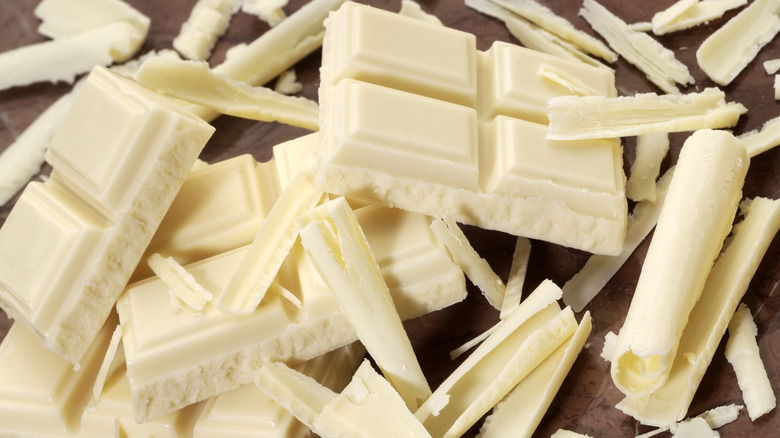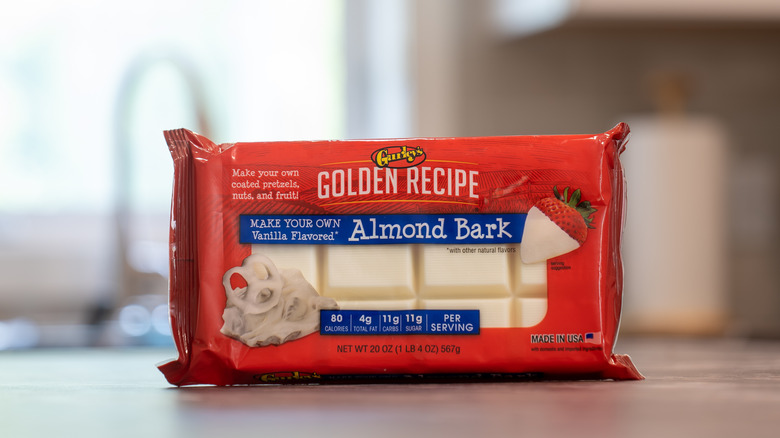Almond Bark Vs White Chocolate: Is There A Difference?
When it comes to satisfying a sweet tooth, anything with chocolate in it reigns supreme in its many forms. Whether you're indulging in velvety white chocolate, rich dark chocolate, classic milk chocolate, or a candy-coating variation, there's a treat for everyone. White chocolate, with its smooth and creamy profile, offers a near-identical texture to almond bark and both delight the palate in their unique way. While some may argue one is an imposter, who can deny they're both delicious?
While both white chocolate and almond bark are undeniably sweet, their flavor profiles do slightly differ. White chocolate creates a velvety finish that tastes sweet with a hint of cocoa in your mouth, while almond bark reminds consumers that it contains mostly oils and sugar with an artificial vanilla aftertaste. Ultimately, these two treats excel in looks but deviate in taste. As for where to find them, just like white chocolate, both vanilla and chocolate almond bark varieties are found in grocery stores across the nation.
The misleading delight that is almond bark
Almond bark's deception lies in its name. Does almond bark have almonds? No. Does almond bark look like chocolate or peppermint bark? Also, no. Instead, almond bark looks almost exactly like a white chocolate bar. Mimicking its chocolate bar shape and off-white color. Although almond bark can easily be mistaken for white chocolate, it deviates from white chocolate through its ingredients and melting style.
It's essential to note that almond bark is not chocolate. Creating almond bark is quick and straightforward. And because it doesn't need to be tempered like chocolate, it's useful for appeasing hangry guests in a pinch. Chocolate is usually tempered to create a smooth, glossy consistency when you want to cover or dip foods in it without it cracking or developing an unappetizing appearance. Since almond bark contains vegetable fats instead of cocoa butter, it does not need to be tempered which makes it both quick and easy to melt compared to the time-consuming effort of tempering chocolate. Plus, it still coats candy, cookies, and fruits easily.
As for flavor, almond bark remains sweet akin to white chocolate but lacks the hint of rich cocoa that cocoa butter leaves in white chocolate, reminding you that it's more of a candy coating than a chocolate coating. So, if you're itching for a crunchy treat with hints of almond, you may want to keep looking in the candy aisle. However, if you want a delicious alternative to white chocolate, that is quick and still contains that sugary bite, almond bark may be just the thing.
The unique flavor profile of white chocolate.
White chocolate is crafted from cocoa butter, sugar, and milk solids with a hint of vanilla. Unlike milk and dark chocolate, it lacks cocoa solids, resulting in a creamy, sweet, and rich flavor profile. This absence of cocoa solids means white chocolate forgoes the berry flavor often found in its darker counterparts, focusing instead on a delightful blend of creaminess and subtle vanilla — so yes, white chocolate is still real chocolate.
White chocolate shines in numerous desserts — think cakes, cupcakes, cookies, and mousses. It can also elevate classic recipes. Consider swapping out traditional chocolate chips for white chocolate chips in your famous chocolate chip cookie recipe or grating some over a tart for an elegant touch. And let's not forget the iconic pairing of white chocolate with raspberries, reminiscent of a delicious mix at The Cheesecake Factory.
Interestingly, regulations around the labeling of white chocolate vary by country. In the United States, companies like Reese's have cleverly marketed their white creme peanut butter cups in a form reminiscent of white chocolate, leading to legal disputes. Regardless: When it comes to baking, whether you choose white chocolate, almond bark, or both, the result is sure to be a delight.


